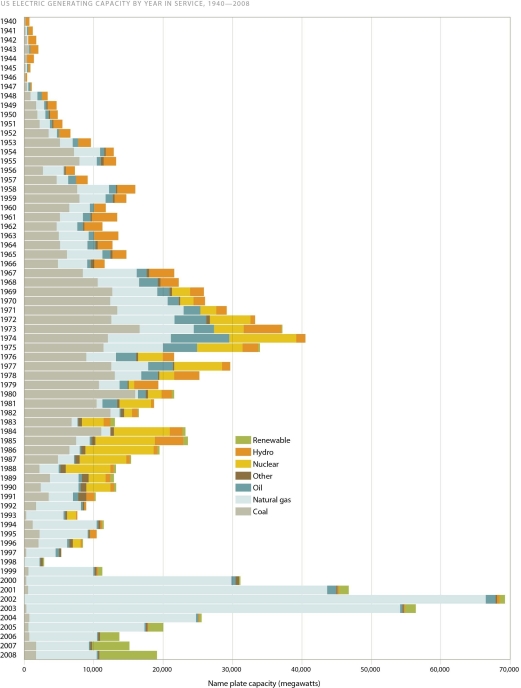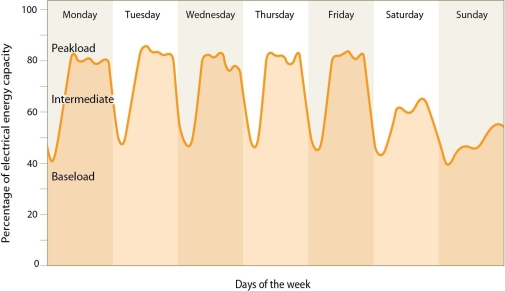A) a coal-fired power plant
B) a large field of windmills
C) a hydroelectric plant
D) a large field of solar cells
Correct Answer

verified
Correct Answer
verified
Multiple Choice
Most supply-side energy policies currently under consideration in the United States
A) suggest a radical restructuring towards renewable resources in the next 10 years.
B) shift our energy resources from fossil fuels to solar,wind,and nuclear in the next 20 years.
C) shift almost half of the current fossil fuel use to hydroelectric power and solar power in the next 20 years.
D) continue to rely on the same fossil fuel resources without significant shifts towards sustainability.
Correct Answer

verified
Correct Answer
verified
Multiple Choice
The EROI for domestically produced oil
A) has been growing since the 1930s.
B) is currently close to that of solar photovoltaics and wind.
C) is much less than for tar sands.
D) makes a good argument for not funding development of renewable energy.
Correct Answer

verified
Correct Answer
verified
Multiple Choice
Reliance on the continued use of fossil fuels is not sustainable because fossil fuels are
A) concentrated in countries that are not politically stable.
B) not significant sources of energy and are increasing in cost.
C) not renewable and contribute to global climate change.
D) not renewable and are primarily from politically unstable regions.
Correct Answer

verified
Correct Answer
verified
Multiple Choice
Which two fuels are currently used at about equal levels in the United States?
A) water power and nuclear power
B) coal and natural gas
C) coal and oil
D) oil and natural gas
Correct Answer

verified
Correct Answer
verified
Multiple Choice
 -Judging by the graph in the figure,if you were going to purchase stock in U.S.companies that generate power in the United States,where would you least likely expect to see future growth?
-Judging by the graph in the figure,if you were going to purchase stock in U.S.companies that generate power in the United States,where would you least likely expect to see future growth?
A) nuclear power plants
B) hydroelectric dams
C) power plants using coal
D) power plants using natural gas
Correct Answer

verified
Correct Answer
verified
Multiple Choice
Although considerable variation exists around the world,globally the percent of fossil fuels that are used for the primary energy supply is more than
A) 85%
B) 60%
C) 50%
D) 35%
Correct Answer

verified
Correct Answer
verified
Multiple Choice
Currently,the greatest supply of natural gas in the United States is
A) associated with petroleum deposits.
B) in gas-rich shale.
C) obtained by chemically converting petroleum into methane.
D) in deposits of coal lying under Arizona and California.
Correct Answer

verified
Correct Answer
verified
Multiple Choice
The future use of electricity to power personal transportation largely depends on
A) more efficient turbogenerators.
B) finding more fossil fuel supplies.
C) low-cost,lightweight batteries that can store large amounts of power.
D) the development of small turbogenerators for automobiles.
Correct Answer

verified
Correct Answer
verified
Multiple Choice
Wars in the Middle East region in the past two decades have been associated with increased
A) efforts to stop global terrorism wherever it exists in the world.
B) demand for natural gas.
C) U.S.interests in Middle East oil.
D) interest in resolving the Palestinian Israeli border disputes.
Correct Answer

verified
Correct Answer
verified
Multiple Choice
The construction of the Alaskan oil pipeline and requirements for more fuel efficient automobiles resulted from
A) the 1970 oil crises.
B) the Gulf War.
C) increased trade with China.
D) a large shift from the use of coal to oil to generate electricity.
Correct Answer

verified
Correct Answer
verified
Multiple Choice
The early Industrial Revolution primarily relied on fossil fuels to
A) run gasoline engines.
B) run power plants that generated electricity.
C) generate steam.
D) generate heat and electricity.
Correct Answer

verified
Correct Answer
verified
Multiple Choice
In the world today,
A) coal is still the dominant fuel.
B) coal has largely been replaced by natural gas for energy supplies.
C) natural gas remains the dominant fuel in the United States.
D) coal and oil are the primary energy supply in the United States.
Correct Answer

verified
Correct Answer
verified
Multiple Choice
 -The light bulbs in this figure are designed to
-The light bulbs in this figure are designed to
A) produce more light than normal bulbs.
B) use less electricity than incandescent bulbs to produce light.
C) be powered by heat from CHP technology.
D) turn off automatically when nobody is in a room.
Correct Answer

verified
Correct Answer
verified
Multiple Choice
Natural gas
A) used in automobiles produces more pollutants than gasoline.
B) when burned in automobiles,produces only water and no carbon dioxide or other pollutants.
C) reserves in the United States may last many decades,even with increased demand.
D) consumption in the United States is declining as available resources decline.
Correct Answer

verified
Correct Answer
verified
Multiple Choice
If oil demands continue,the United States will likely increase its importation of oil from
A) OPEC and the Middle East.
B) China.
C) Russia.
D) the Western Hemisphere.
Correct Answer

verified
Correct Answer
verified
Multiple Choice
Increased reliance upon oil imports have generally paralleled
A) increased interest and involvement in Middle East politics.
B) increased interest in fighting global hunger.
C) decreased reliance on other fossil fuels.
D) decreased efforts to explore alternate forms of fuel.
Correct Answer

verified
Correct Answer
verified
Multiple Choice
Instead of only generating more electricity,rising energy demands may also be met by
A) switching from natural gas to coal.
B) switching from coal and natural gas to windmills and solar technologies.
C) increasing the efficiency of energy consumption.
D) using more nuclear power instead of fossil fuels.
Correct Answer

verified
Correct Answer
verified
Multiple Choice
 -Examine the changes in electrical demand in the United States.The daily drop in electrical consumption is most closely associated with
-Examine the changes in electrical demand in the United States.The daily drop in electrical consumption is most closely associated with
A) people heading off to work.
B) people sleeping.
C) home heating and cooling systems.
D) daytime activities that consume little energy.
Correct Answer

verified
Correct Answer
verified
Multiple Choice
On a winter day,most automobiles keep the passengers warm by using heat generated by the engine.This use of the heat by-product from a gas engine is an example of
A) non-fossil-fuel energy.
B) CHP technology.
C) nuclear power.
D) a sustainable source of energy.
Correct Answer

verified
Correct Answer
verified
Showing 21 - 40 of 96
Related Exams